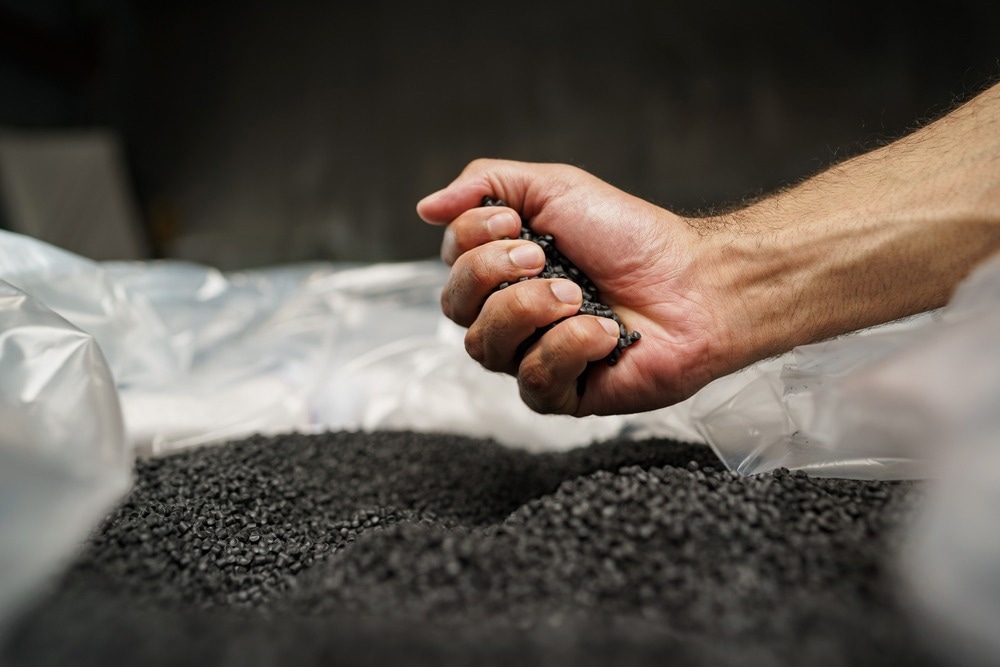New research has appeared in the journal Composites Part C: Open Access investigating the benefits of using pyrolysis and compatibilizers to produce sustainable biocomposites from biodegradable plastics and biofuel co-products.

Study: Sustainable Biocomposites from Biofuel Co-Product and Biodegradable Plastic: Effect of Pyrolysis and Compatibilizer on Performance. Image Credit: FabrikaSimf/Shutterstock.com
The Problem with Plastics
Plastics are products which have helped define modern industrialized society. Despite their many benefits including ease of production, cost-effectiveness, versatility of use, and favorable mechanical, thermal, and physiochemical properties, the use of plastics comes at a major environmental cost.
Conventional polymeric materials produced from hydrocarbons are non-biodegradable, leading to their proliferation in the environment for vast periods of time. Additionally, the manufacture of plastics has increased exponentially since their widespread introduction in the mid-20th century and the rise in single-use plastics has led to astronomical levels of waste in the oceans and on land.
Once in the environment, plastics break down over time due to physical, chemical, and microbial actions, causing the formation of microplastics, which have become a key environmental and human health issue. It is estimated that humans ingest between 11,845 and 193,200 microplastics annually, and the long-term risks to human health are still poorly understood.
Plastic production also plays a significant role in climate change due to the emission of greenhouse gases before, during, and after their manufacture. Additionally, once they begin to break down in the environment, plastics release potentially toxic chemicals, further causing damage to fragile ecosystems.
Biodegradable Plastics
Biodegradable plastics have been widely proposed as a solution to this key environmental issue. Once they reach the end of their useable life, these polymeric materials are degraded into carbon dioxide, water, methane, and microbial biomass. Biodegradable plastics are categorized based upon the environment they are designed to degrade in.
Despite their benefits for mitigating environmental damage, biodegradable plastics are limited by several factors. They are relatively expensive to produce compared to conventional polymers, due to factors such as feedstock acquisition, processing difficulties, and infrastructure cost. They also require vast amounts of arable land to produce, which can cause issues with food security.
Utilizing Fillers from Agricultural Waste
To overcome the issues with biodegradable plastics and aid their commercial viability, multiple researchers in recent years have explored the use of cheap fillers from agricultural waste in biocomposites. These sustainable polymers have already found application in sectors such as the automotive industry.
One industry which has provided researchers with attractive sources of fillers is the rapidly expanding corn ethanol industry. This industry has become a key producer of biofuels for transportation and industry. DDGS is a major by-product of this industry. This product contains substantial amounts carbohydrates, proteins, ash, and oils.
Whilst the nutritional profile of DDGS is highly favorable for use as animal feed, there is still a vast amount of this valuable by-product that goes to waste. This makes it a cost-effective, attractive organic material to produce biocarbon which can be used in industries such as bioplastics. This bio-based filler can be used as a direct filler or post-thermal treatment. Torrefaction and pyrolysis are used to produce thermally treated DDGS.
The Study
The authors behind the study have compared the effects of heat treatments and compatibilizer additions on DDGS-filled biocomposite properties. The compatibilizer used was maleic anhydride. Both heat-treated and untreated DDGS samples were blended with PBSA.
According to the authors, there is a growing body of literature on DDGS- reinforced biocomposites. However, there has been no specific study, to the authors’ knowledge, on the investigation of DDGS-reinforced PBSA biocomposites. PBSA is a biodegradable polymer with favorable mechanical properties which make it an attractive candidate for applications such as biodegradable packaging. However, its prohibitive cost hinders its widespread commercial use.
There has been some evidence in recent papers that DDGS fillers can enhance the degradation rate of biocomposites compared to polymers without filler incorporation. Along with enhanced thermal and mechanical properties of biocomposites, this makes DDGS fillers extremely attractive for the biopolymer industry.
In the study, DDGS inclusion in biocomposite samples enhanced their flexural and tensile moduli. Incorporating compatibilizers improved heat deflection temperatures, tensile strength, and flexural strength in both heat-treated and untreated PBSA samples. Noteworthy improvements in flexural and tensile strength were observed in untreated samples.
This study has demonstrated the benefits of incorporating DDGS, a major by-product of the biofuel industry, into biodegradable polymers. Compatibilizers were also demonstrated to be advantageous for this purpose.
The favorable mechanical and thermal properties of biocomposites, alongside the already publicized advantages in enhancing degradability of biopolymers, makes this approach a cost-effective option for manufacturing commercially viable biodegradable biocomposites for use in the plastics industry to phase out environmentally harmful hydrocarbon-based polymers.
More from AZoM: Auger Electron Spectroscopy in the Semiconductor Industry
Further Reading
Lim, J et al. (2022) Sustainable Biocomposites from Biofuel Co-Product and Biodegradable Plastic: Effect of Pyrolysis and Compatibilizer on Performance Composites Part C: Open Access 100301 [online, pre-proof] sciencedirect.com. Available at: https://www.sciencedirect.com/science/article/pii/S2666682022000652?via%3Dihub
Disclaimer: The views expressed here are those of the author expressed in their private capacity and do not necessarily represent the views of AZoM.com Limited T/A AZoNetwork the owner and operator of this website. This disclaimer forms part of the Terms and conditions of use of this website.